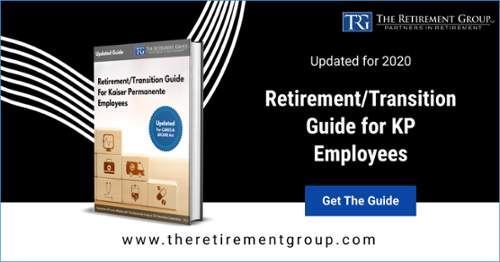With all the volatility in the market a lot of my clients have been asking about their 401(k)s. I've notice a lot of these clients have been from Kaiser Permanente specifically. While I'm not a financial advisor, I did do some research and here is I've found concerning Kaiser Permanente's 401(k)k/TSA plans:
If it’s been a while since you've checked on your 401(k), you’re not alone. 73% of plan participants spend less than five hours researching their 401(k)/TSA investment choices each year, and when it comes to making account changes, the story is even worse.
When you retire, if you have balances in your 401(k)/TSA plan, you will receive a Participant Distribution Notice in the mail. This notice will show the current value that you are eligible to receive from each plan and explain your distribution options. It will also tell you what you need to do to receive your final distribution.
Note: Kaiser Permanente is mainly a non-profit organization. Therefore, most employees will have a TSA (Tax-Sheltered Annuity), also known as a 403 (b) retirement plan, instead of a 401(k). While most properties are mutual, you should ask your advisor about differences.
Note: If you voluntarily terminate your employment from Kaiser Permanente, you will not be eligible to receive the annual contribution.
When faced with a problem or challenge, many of us are programmed to try to figure it out on our own rather than ask for help. The Christmas Eve ritual of assembling toys without looking at the instructions and that road trip when we refused to stop to ask for directions come to mind. But when we’re talking about 401(k)/TSA investing, choosing to go it alone rather than get help can really hurt.
Over half of plan participants admit they don’t have the time, interest or knowledge needed to manage their 401(k)/TSA portfolio. But the benefits of getting help go beyond convenience. Studies like this one, from Charles Schwab, show those plan participants who get help with their investments tend to have portfolios that perform better: The annual performance gap between those who get help and those who do not is 3.32% net of fees. This means a 45-year-old participant could see a 79% boost in wealth at age 65 simply by contacting an advisor. That’s a pretty big difference.
Getting help can be the key to better results across the 401(k)/TSA board. A Charles Schwab study found several positive outcomes common to those using independent professional advice. They include:
- Improved savings rates – 70% of participants who used 401(k)/TSA advice increased their contributions.
- Increased diversification – Participants who managed their own portfolios invested in an average of just under four asset classes, while participants in advice-based portfolios invested in a minimum of eight asset classes.
- Increased likelihood of staying the course – Getting advice increased the chances of participants staying true to their investment objectives, making them less reactive during volatile market conditions and more likely to remain in their original 401(k)/TSA investments during a downturn. Don’t try to do it alone.
In-Service Withdrawals
General Rules: You may withdraw amounts from your account while still employed by an employer under the circumstances described. Certain withdrawals are subject to regular federal income tax, and if you are under age 59 1⁄2 you may also be subject to an additional 10% penalty tax. You can determine whether you are eligible for a withdrawal, and request one, via internet access or by calling the KP Benefits Center.
Rolling Over Your 401(k)/TSA
As long as the participant is younger than age 70 ½, an in-service distribution can be rolled over to an IRA. A direct rollover would avoid the 10% early withdrawal penalty as well as the mandatory 20% tax withholding. Refer to your SPD for more information & possible restrictions on rollovers/withdrawals.
Because a withdrawal permanently reduces your retirement savings and is subject to tax, you should always consider taking a loan from the plan instead of a withdrawal to meet your financial needs. Unlike withdrawals, loans must be repaid, and are not taxable (unless you fail to repay them). In some cases, as with hardship withdrawals, you are not allowed to make a withdrawal unless you have also taken out the maximum available plan loan.
Note: The Plan Administrator reserves the right to modify the rules regarding withdrawals at any time, and may further restrict or limit the availability of withdrawals for administrative or other reasons, in its sole discretion. All participants will be advised of any such restrictions, which will apply equally to all employees.
If you are looking for more details about your benefits, reach us at TechStaffer.
If you are wanting to get a better understanding of your KP benefits, visit: https://techstaffer.blog/2020/02/28/a-deep-dive-in-kaiser-permanente-employee-benefits/
If you want to better understand the various stages of retirement, visit: https://techstaffer.blog/2020/01/16/the-various-stages-of-retirement/
Sources:
- The Retirement Group or www.theretirementgroup.com
- “Retirement Plans-Benefits & Savings.” U.S. Department of Labor, 2019, www.dol.gov/general/topic/retirement.
- “Generating Income That Will Last throughout Retirement.” Fidelity, 22 Jan. 2019, www.fidelity.com/viewpoints/retirement/income-that-can-last-lifetime.
- Kaiser Permanente Summary Plan Description, 2017




